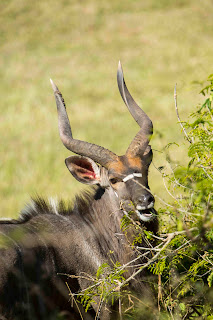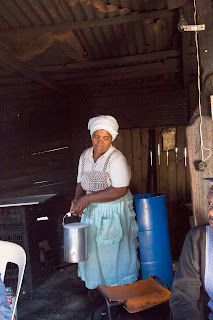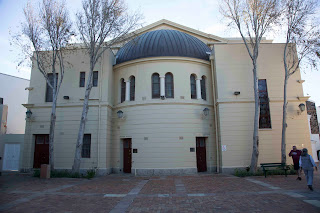We have had no downtime, and tomorrow we are off to Zambia then Botswana and will be out of internet access. I am furiously trying to at least get some photos up. The blog will be forthcoming.
South Africa with Craig and Jeri
Thursday, May 16, 2013
Wednesday, May 15, 2013
Day 6: Transfer to Mala Mala and Start of Our Safari
I am now back with the living, but I passed on poached
eggs this morning. Clive and
Godfrey picked us up on yet another beautiful morning in Cape Town (I think
they tell all the tourists that they are lucky with the weather, but it really
is gorgeous all the time). At this
point, I would like to put in a good word for Clive de Bruyne and his company, The Cape Town Tour Guide Co. (www.capetowntourguide.com,
tours@capetowntourguide.co). He
was amazing. All of his
arrangements were spot on, he listened to our requests and accommodated us
perfectly. In addition to making
all the arrangements, he accompanied us on all the hikes and the cycling, and
he and Godfrey took care of getting us through the airport right up until
security. All six of us felt that if you are visiting Cape Town, you MUST first
call Clive.
Our
flight to Nelspruit/Kruger was about 2 1/2 hours and very uneventful. We were met at the airport by a driver
arranged for us by Boundless Journeys and then took the "short" 2 1/2 hour drive to our camp, Mala
Mala. The drive was over some
pretty bad roads to start and end with, getting our bodies ready for our safari
game drives. When we exited the
main road, we entered s gste to Sabi Sands game reserve on the edge of Kruger
National Park. We though we were
there. Next we saw a sign for Mala
Mala- 20 km!, at least another 45 minutes. Fortunately, we were kept very busy
for the ride. Our fist sighting
was a kudu, one of the many ruminants that are found in the area, this was
followed soon after by a heard of giraffe, amazingly graceful animals given
their ungainly legs and necks. As
we got closer to the camp, we ran into several groups of impalas that seemed
not even to notice our presence.
We finally reached our destination, Mala, Mala. The first thing we saw as we drove up
was Molly waving. It was great to see Molly and Dave and have them join us for
the rest of the trip. (Don't tell
anybody in our group that i said this,
but they are all really great to travel with-easy going, though
all of us are type A+ at home, and
a lot of fun). They had been
patiently waiting for us so we could take our evening game drive. Our guide for the next three days,
Morne (pronounced "Mornay"), met us and gave an introduction to the
camp and a quick briefing.
Mala
Mala is not your typical camp. The
area is consists of several stone units with thatched peak roofs and an indoor
and outdoor dining area that overlooks a river allowing for animal viewing any
time. This is the same view that
we have from our enormous duplex we share with Harriet and Rick. Our unit has 2 self contained areas
that consist of a huge bedroom with sliders to a patio facing the river (on
which I am presently sitting and watching 2 elephants), 2 full bathrooms (his
and hers), and a giant walk in closet/dressing room. Rick and Harriet's unit
was the same, and then we shared a common area/living room that was
gigantic. After having visited the
hostels in Langa 3 days ago, we are reminded yet again, as to how lucky we
are. The camp also has an exercise
room, sauna, and nice gift shop.
As you enter the camp proper, there is a stutue of multiple warthogs of
varying sizes, and the grounds are landscaped beautifully. There is also a BOMA (British Officers'
Meeting Area a hold over from the Boer war in the 1800's when British officers
would meet after a day's fighting to drink and schmooze around a
campfire). This was where our
evening meal was served after our evening game drive.
We
quickly unpacked, grabbed our gear, and hightailed it to the meeting area. Morne told us the rules- no standing,
and NO TOUCHING HIS GUN. Otherwise, have a great time. Our vehicle for the next three days was
a specially modified opened truck with four rows of stadium seating, allowing
excellent viewing for everyone.
Off
we went, leaving at about 3:30pm.
The advantage of staying at a private reserve compared to Kruger which
is owned by the South African government, is that there are no rules about when
and where you take you vehicles.
We were allowed to be out at night which is when there is an abundance
of activity, as well as drive off road which we all were to find was great fun.
There were reports of a pair of leopards roaming about, so off we went to check
this out. Along the way, we found
gobs of fresh elephant dung and urine,
and then, guess what, elephants, loads of them with several very young
(Morne estimated 3 months old), juveniles, and adults.
The
excitement over the elephants soon merged with our next find, the
leopards. We were starting to lose
the light for photography, but I did manage to get a few bizillion
pictures. Unfortunately (or fortunately
if we were the prey), they weren't too interested in hunting right then.
We
couldn't believe our luck, because next up was a pride of lions with a female
cub. I actually heard them before
seeing them. We had stopped for a
quick bathroom break, and as a stood there contemplating how clean the
facilities were, I was sure I heard what I thought was a low lion's
grumble. No one else believed me
until a few seconds later, when we were back in the truck, and rounded the
first bend not 50 yds from our bathroom au naturel, we spotted the group of 9
lions. They were lounging on a dried riverbed enjoying the cool of the evening.
There wer 2 males, a cub and the remainder females. Two other cubs had been
killed, the last one last week by a male lion. Another of the lions was an old female who because of poor
dentition, was going to die soon.
Her teeth were severely worn and some lost. Though there was very little light, the guides have strong
spots that do a great job of illuminating the wildlife, and photographs were
doable but not easy. They try very
hard not to shine light on prey, since this will blind them for a bit and make
them more easily a dinner.
After
a successful night's viewing, we headed back to camp for a wonderful dinner in
the BOMA with a campfire and a canopy comprised of trees and stars. The night sky here is amazing with
virtually no light pollution, a small crescent moon, and great air quality, you
feel like you can reach out and touch the Milky Way. Tomorrow I hope to have time to get some night sky pictures
for you.
Tuesday, May 14, 2013
Day 5: Cape Town- Stellenbach
I missed today with a bout of food poisoning. Jeri and the rest of the group went and it was gorgeous. They all took photos and will hopefully write this entry.
I have recovered as of tomorrow for our trip to Mal Mala, just outside Kruger National Park and the start of our safari.
I have recovered as of tomorrow for our trip to Mal Mala, just outside Kruger National Park and the start of our safari.
Sunday, May 12, 2013
Day 4: Cape Town: Langa Township and South African Jewish Museum
We apparently have been extremely lucky with the weather. Clive told us that visitors can come for 3 or 4 days without ever seeing the top of Table Mountain. This morning was again gorgeous. Godfrey, Clive's associate, was our guide for the day on his home turf, the township, Langa. Townships are found in all areas in S. Africa and represent some of the lasting effects of apartheid. Langa is one of the smallest with a population of 250,000 with some larger townships, like Soweto in Johannesburg, having over 1 million. Before heading to Langa, we stopped in the area of District 6. Cape Town was divided into several districts, and District 6 happened to be a mix of Black, White, and Coloured (which included mixed racial, Indian, etc.) South Africans. They all lived together in harmony until apartheid. In the early 60's the government decided to bulldoze the entire district and to evict the whole population.
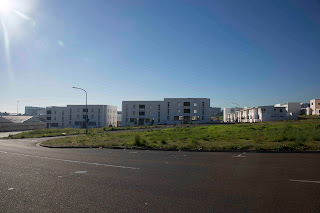 |
| District 6 |


Next up was lunch in the township. After our pub experience we were pretty sure lunch was not going to happen. We were pleasantly surprised to find our restaurant in a more affluent (as opposed to the more effluent area we had just departed) section. The restaurant was owned by Sheila, a great hostess with a wonderful sense of humor. Lunch consisted of about 15 different items laid out buffet style which included several local vegetarian dishes as well as both a kudu and an ostrich dish. Everything was delicious, though my gi tract had taken a turn for the worse after breakfast. As it turns out, I had developed food poisoning which caused a bit of distress for the next 24 hours or so.
 |
| Sheila |
Our final stop in Langa was a house visit to one of the hostels (not anything like what we call a hostel). There are three levels of housing in the townships. The nicest are the "civil servant" houses, which are single family homes. The next level down is "informal housing", attached ramshackle houses with corrugated tin roofs. Bathrooms consist of port-o-potties, though since the end of apartheid, water and electricity run into most of these. Illegal electricity is a big problem leading to many rapidly spreading fires amongst the contiguous structures. Satellite dishes are also omnipresent. I guess everyone in the world has to watch "American Idol". These homes, though often dilapidated on the outside, are kept nicely furnished inside, a testament to their pride in ownership. The final type of living quarters is the most disturbing, the "hostels". These are owned by the government, and were originally designed as an apartment for Black male workers in Cape Town. The apartment consisted of 3 bedrooms, each for 2 men, a bathroom and shower, and a common area with a sink and large table. During apartheid, in order to accommodate the huge numbers of displaced families, 6 entire families often consisting of 8 or 9 people each were crammed into these apartments. Birth control is virtually non-existent leading to very large families. Extended families, including nieces and nephews , aunts and uncles can also be found sharing the space originally planned for a single male worker. At night, mattresses are placed on the floor. 20 years after apartheid ended, these families are still living in this manner. Lighting is poor from only a few bare bulbs, paint is peeling from the walls, and a tiny dorm refrigerator and hot plate are what pass as kitchen appliances. According to Godfrey, who was born in Langa and continues to live here, the sense of community is so strong, that people find it hard to leave. Godfrey tried living in the city for about 3 months and felt so isolated that he returned to Langa and is very happy here. Though he was born in informal housing, he now lives in the civil servant housing with his wife and son.
Because it was a Sunday and the schools were closed, we were unable to see inside a school. Education is compulsory to age 16, and schools are free, but if you want to send your child to the "good school," you need to pay for "supplies and fees". Godfrey is sending his son to day care now, and will send him to the private public school next year when he turns 6.
 |
| Hostels |
 |
| Informal Housing |
We left Langa somewhat subdued, and somewhat in shock, but with a much better understanding of the terrible effects that apartheid had on Black South Africans. What we cannot understand is why the present regime, many of the leaders of which came from the townships, have not done more to improve the standard of living other than to make unfulfilled promises.
By the time we left Langa it was getting pretty late, and it unfortunately left us with only an hour to visit the South African Jewish Museum. I was particularly interested in Jewish settlement in the late 1800's since my maternal great-grandfather came here briefly with his brother to seek their fortune in the diamond mines. They eventually emigrated to America and brought their families including my grandfather to NYC. If it were different, I may have had a funny accent also (Clive, if you're reading this, I'm just kidding).
After a whirlwind at the museum, I started to feel downright awful, so Godfrey dropped me at the hotel, then the rest of the crew rode up to Signal Hill adjacent to Table Mountain to watch the sunset.
 |
| South African Jewish Museum |
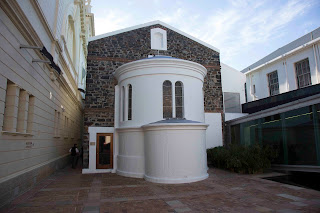 |
| 1st Synagogue in Cape Town |
 |
| Bridge to Nowhere |
Subscribe to:
Posts (Atom)

































